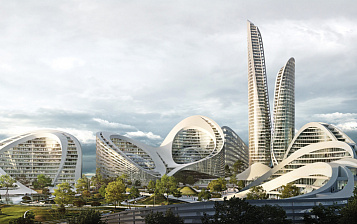"Cities-gardens", well-thought-out block development and other ways to return to the comfort zone for Russians
Spring 2020 will surely be remembered by many. The global economy has experienced an unprecedented shock and tuned in to further global changes, and almost 2 billion inhabitants of the Earth (according to the Guardian, or more than a billion according to the “conservative” estimates of AFP and Le Monde) were quarantined in March.
Renovation against "garden cities"
In Europe, as you know, Italy suffered the most from the coronavirus, but even there, construction sites were the last to go into quarantine, continuing to work in the fresh air and underground to the stop. What can we say about Russia (however, this is also true for panicking Ukraine and calm Belarus), where there are many times fewer cases, and the construction industry seemed to be aiming for a record in the spring of 2020: the metro, energy facilities, culture and housing and communal services, bridges in all regions, roads and flyovers, thanks to the warm winter, were built even more actively than before. The situation turned out to be more difficult in the field of residential construction, where, after the collapse of oil prices, there was an obvious decline in supply and demand. But even here the public sector does not lose optimism, helping construction companies with Moscow renovation - the very one whose pace Mayor Sobyanin recently promised to triple. Indeed, right now 147 complexes are being built in Moscow under this program. The first built objects are already there, and at the end of the year the appearance of the sleeping areas of the capital will change dramatically for the first time since the 1950s, after which the successful experience will be extended to the whole country. It is all the more interesting to look at the withdrawing nature - quiet Moscow courtyards with their "Khrushchevs", in which up to 1.6 million people could get stuck at remote work this spring.
It's hard to believe, but these strange, many called "poor" houses were built as part of the idea of a "garden city", using French and English practical experience, and theoretical calculations of such gurus of architecture as the leaders of the Bauhaus, as well as Le Corbusier and Ebenezer Howard. The latter more than 120 years ago, at the end of the 19th century, pondered the eternal disorder of the English slums, and came up with a "garden city". Despite the “leftist” context of his ideas, they took root in our country even before the USSR. As "garden cities" were conceived by the architects of the 1910s, many future cities along the then-constructed Trans-Siberian Railway. The first Soviet urban planning projects mainly concerned workers' settlements and were promoted in the same way as "garden cities" (that was what Mayakovsky prophesied in the famous stanza). Of course, the “ideal city” created within the framework of VDNKh was also primarily a garden and park ensemble, at the same time with “residential” and “farming” areas.
Moreover, the general plan for the reconstruction of Moscow, carried out under the leadership of Shchusev in 1924, rightly based on the fact that more than half of the capital has been occupied by greenery since pre-revolutionary times, also spoke of the inevitability of a “garden city”. It was at that time that the concepts of “Big” and “New” Moscow appeared, in the reality of which we found ourselves already in the 21st century. And although some of the ideas of city planners did not come true (for example, about predominantly low-rise buildings beyond the Garden Ring), the emergence of a new dominant in the very center of the metropolis in the form of Zaryadye Park, supported by a ring of huge park areas around the entire perimeter of the city, is very close to the ideas of E. Howard.
There are even more amazing parallels if we analyze a lot of individual projects.
Even Moscow City was originally conceived and designed as a typical circular garden city with a large park in the center. But what does Khrushchev have to do with it - you ask.
The fact is that this key element of the Russian urbanization of the 20th century was also embodied in the framework of the development of the concept of the “garden city”. Yes, the Soviet construction industry failed with materials, ensuring a consistently low quality of load-bearing structures. Yes, the then light industry did not allow citizens to settle in a new format of housing (and if Soviet Russia had its own IKEA, which rose in Sweden exactly on the arrangement of similar Khrushchev houses - small Swedish reinforced concrete houses, the impression of life in five-story buildings could be completely different! ). Yes, the social situation in the USSR led to the fact that in a small apartment, carefully designed for a married couple with children, they had to crowd with their parents, and often with many other relatives, turning existence on modest square meters into some kind of nightmare.
However, the deep ideas embedded in these green microdistricts have been embodied in many ways. Cozy, quiet, safe courtyards, filled with greenery, specially reaching the roofs, created an atmosphere of comfort and tranquility, which is so often nostalgic for those who remember it. “The main cell of the “garden city” is a one-family apartment - a two-story villa. Villas are located nearby. Then they are placed on top, resulting in a multi-storey building,” wrote Le Corbusier. This phrase has long been the subject of ridicule, however, the atmosphere of the microdistricts created in the 1960s, as far as possible from the rhythms and noises of the largest city in Europe, by itself proves that many of the ideas of the great Swiss turned out to be embodied. However, of course, Soviet microdistricts inherited not only Western fashions, but also the ideas of our great compatriots. The color and geometric concept of microdistricts of Soviet cities was based on the developments of Malevich (who even predicted strange combinations of colors in mass development areas, where endless rivers of concrete boxes coexisted with green areas comparable in size). Years after the tragic death, there was a place for the ideas of El Lissitzky, who was one of the first to predict "horizontal skyscrapers" embodied first in Soviet mega-long "Khrushchevs" (reaching 726 meters in Moscow in length, that is, twice "greater" than the height of the current towers "Federation", and in other cities, for example, in St. Petersburg and Volgograd, even exceeding 1100 meters). Years will pass and the horizontal skyscraper Raffles City in Chongqing will become one of the main architectural and construction achievements of the 2010s in the world.
In the Russian historical tradition, it is customary to divide history according to the years of the reign of tsars and general secretaries. Hence the confrontation between “Khrushchev” and “Stalinka”, although they were made by the same architects as a result of the natural evolution that began in the 1940s (concrete concrete factories and standard blocks were built already then, like the first projects of M. Posokhin and engineer V. Lagutenko, future authors of five-story buildings of the K-7 series). And the external difference between them only reflects the property stratification of the USSR with a sharp difference between elite and standard budget housing (which is built simultaneously under capitalism, and sequentially under communist rule). So the idea of the “garden city” of Howard and Corbusier did not disappear from the minds of Russian architects, just like the legacy of Soviet constructivists. And it was not a love of trees! The environmental agenda was surprisingly far from the "green architecture" of the USSR. It was about trying to create an architecture commensurate with the common man, which would not put pressure on him like “high-rises”, but mixed with trees, drowned in them and faded into the background, and the first would have a basic sense of security and collectivity. It was only in the 21st century that the idea of destroying the Soviet districts as a class and moving from planned district development to targeted and only occasionally quarterly development began to win. At least, this is the opinion of the mouthpiece of the capital's construction industry, Moscow Perspective, which calls, as part of the renovation, to free Russia from the most noticeable results of the socialist experiment in the form of "Khrushchev". Perhaps a hundred years of socialist experiments in architecture is really enough.
The idea of a "garden city" by Howard and Corbusier did not disappear from the minds of Russian architects, just like the legacy of Soviet constructivists.
Developers for "garden cities"
However, how far we have gone from the concepts of the "garden city" in our time is a big question. The most successful middle-class projects in recent years have again and again exploited Le Corbusier's favorite image: graceful, elongated rectangular skyscrapers surrounded by oceans of greenery. It was this positioning of projects that once allowed the construction of the Scarlet Sails, and is now embodied by numerous residential complexes along the spacious Moscow parks: from the residential complex Botanchesky Sad to the residential complex Nebo. Even in the center, the Capital Towers skyscrapers that have risen rapidly by 200 meters near Moscow City are planned to be connected with the 1905 Goda park by special bridges.
Modern materials, primarily high-quality Russian formwork, such as Delta, Dialog or PSK-KAP, ensure high quality for new projects.
Now no one will say that these houses are “only 25 years old” (another myth attributed to the “Khrushchevs”). Who knows, but perhaps on the wave of interest in the Bauhaus, whose centenary was recently actively celebrated around the world, interest in low-rise block buildings will also be revived. Even in Moscow, which loves to compete with New York, development trends are extremely diverse. According to experts, the quarterly well-thought-out development of whole new districts, carried out in Kommunarka and ZIL, is a great success among buyers. The development of the vast territory of the Hammer and Sickle plant with low modernist buildings with vast green courtyards is completely reminiscent of both the Soviet districts of the 1960s and the famous master plan for the development of Barcelona in the 19th century. Truly, in the world of ideas, nothing is completely lost! The concept of the "garden city" did not let go of Russian architects for decades.
Tsars, leaders, general secretaries, and presidents have changed, but the “garden city” has always stirred the imagination and served as an effective point of consolidation for the desires of architects, developers, and end users. Moscow, as a really turbulent metropolis in its development, most likely, of course, will lose five-story buildings hiding in the shade of half-century-old trees, but there were already about 15% of the housing stock in the capital. And in many other regions, this figure reaches 30-40%. The situation of Omsk is typical, which, with the help of “Khrushchev”, got rid of the label attached by F. M. Dostoevsky himself, for whom he was like a “nasty little town”, in which there are no trees at all and a lot of dust. In the 1950s, Omsk received all-Union recognition as the first major "garden city", after more than half a century the name became boring, but all polls show that green zones are one of the few unambiguously positive symbols of the native city for its residents. And such are dozens of other cities in Russia: from Yekaterinburg (remember, its summer battles for the square) to St. Petersburg, the main development project in the center of which in the 2020s seems to be a large park.
Epidemics, financial crises and other bad weather will pass, but a good view from the window, clean air and convenient infrastructure will obviously always be important. The question is - will they come up with such a spectacular name for this in the 21st century as 120 years ago?


 DOWNLOAD
DOWNLOAD LOOK
LOOK Top Content of the Month
Top Content of the Month


